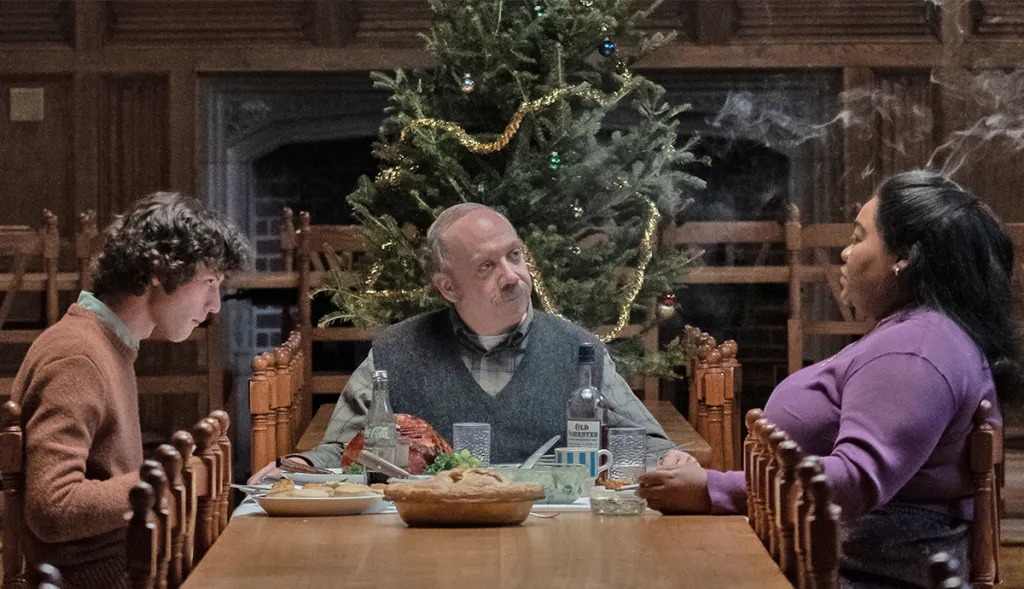 A scene showing a New England prep school chapel in the early seventies, filled with distracted boys in their coats and ties? Been there, done that. Alexander Payne’s wonderful movie “The Holdovers” is set in a fictional school called Barton over the 1970-71 holiday break. I went to a different school back then, but Barton is pretty much the same — red-brick, federalist-style buildings and icy paths across snowy lawns that made my feet feel cold and wet even though I was sitting with Kathy in a theater in Arcadia.
A scene showing a New England prep school chapel in the early seventies, filled with distracted boys in their coats and ties? Been there, done that. Alexander Payne’s wonderful movie “The Holdovers” is set in a fictional school called Barton over the 1970-71 holiday break. I went to a different school back then, but Barton is pretty much the same — red-brick, federalist-style buildings and icy paths across snowy lawns that made my feet feel cold and wet even though I was sitting with Kathy in a theater in Arcadia.
The movie’s about an ancient civilizations teacher, Paul (Paul Giamatti, from Payne’s “Sideways”), who has to stay on campus over the holidays to look after a junior, Angus (Dominic Sessa). In a Dickensian flourish, Angus’s mother and her new husband wanted to go on their honeymoon instead of seeing him. Seeing the boys in the dorm before the break began triggered my not-fitting-in angst. A family name got me into prep school rather than the proficiency at academics and sports most of the kids shared.
Yet what a bubble of privilege we inhabited. In the chapel scene, the cafeteria manager, Mary Lamb (Da’Vine Joy Randolph), is in the front row, receiving the condolences of the presider for the death of her son, Curtis, in Vietnam. The presider’s called a priest, which almost certainly means he’s Episcopal. As he demonstrates, back then, which was not that long ago, adding “Happy Hanukkah” to “Merry Christmas” was a laugh line.
It’s probably the first time Mary has been in the front row at chapel. In my time, preppies weren’t especially encouraged to notice or thank those who cooked, cleaned, and served. Mary had taken the job at Barton so Curtis could attend for free, but she couldn’t afford college, so he was drafted. In her expression as the priest speaks, we can see that her grief and rage are still well beyond the grasp of ritual. And then she has to stay and cook for the holiday holdovers, whose insensitivity to her grief infuriates Paul.
Vietnam was a risk for relatively few prep school boys, either because of deferments in the sixties or, by the Nixon era, when the movie is set, the draft winding down. Payne appropriates the era’s languid cinematic style and even reverts to old corporate and “rated R” logos and sans serif fonts for the titles. Boomers know what I’m talking about. But we don’t even hear the word Vietnam. Except for Paul’s musings on the decline of civilization, Barton and the movie feel sealed off. The Rolling Stones throbbed in our dorms but not on the soundtrack. The only period songs were by Cat Stevens and the Allman Brothers, but not the most obvious choices.
Instead, sacred Christmas music predominates. This is where Payne departs from his movie’s relatively cynical seventies antecedents. He and writer David Remington have a lot to say about love and sacrificing for others. I agree with Carrie Preston, who plays one of Paul’s Barton colleagues, offering him a wistful hint of romance, when she calls “The Holdovers” a great holiday movie. I know I’ll want to see it again at Christmas. Payne mutes the topical references to keep our attention on Mary, Paul, and Angus as they grapple with grief, regret, addiction, and mental illness and make of themselves, if only for a couple of weeks, a family – since when two or more are gathered, and their hearts are open, there is always room at the inn.
